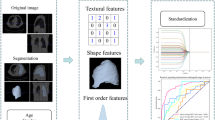Abstract
Lung cancer is the most common cause of cancer-related death worldwide. One of the most significant negative prognostic factors is the occurrence of metastasis. Recently, one of the promising way to diagnose cancer samples is to use the image data (PET, CT etc.) and calculated on the basis of these images so called radiomic features. In this paper we present the attempt to use the radiomic features to predict the metastasis for lung cancer patients. We applied and compared three feature selection methods and two classification methods: logistic regression and support vector machines. The obtained accuracy of the best classifier confirms the potential of the radiomic data in prediction of metastasis in lung cancer.
Access this chapter
Tax calculation will be finalised at checkout
Purchases are for personal use only
Similar content being viewed by others
References
Aerts, H.J.W.L., et al.: Decoding tumour phenotype by noninvasive imaging using a quantitative radiomics approach. Nature communications 5, 4006 (2014). https://doi.org/10.1038/ncomms5006
Brierley, J.D., Gospodarowicz, M.K., Wittekind, C.: TNM classification of malignant tumours. John Wiley & Sons (2017)
Cruz, C.S.D., Tanoue, L.T., Matthay, R.A.: Lung cancer: Epidemiology, etiology, and prevention. Clin. Chest Med. 32(4), 605–644 (2011). https://doi.org/10.1016/j.ccm.2011.09.001
d’Amico, A., Borys, D., Gorczewska, I.: Radiomics and artificial intelligence for PET imaging analysis. Nuclear medicine review. Central Eastern Europe 23(1), 36–39 2020). https://doi.org/10.5603/NMR.2020.0005
Fujarewicz, K., et al.: Large-scale data classification system based on galaxy server and protected from information leak. In: Nguyen, N.T., Tojo, S., Nguyen, L.M., Trawiński, B. (eds.) ACIIDS 2017. LNCS (LNAI), vol. 10192, pp. 765–773. Springer, Cham (2017). https://doi.org/10.1007/978-3-319-54430-4_73
Gillies, R.J., Kinahan, P.E., Hricak, H.: Radiomics: Images are more than pictures, they are data. Radiology 278(2), 563–77 (2016). https://doi.org/10.1148/radiol.2015151169
van Griethuysen, J.J.M., et al.: Computational radiomics system to decode the radiographic phenotype. Cancer Res. 77(21), e104–e107 (2017). https://doi.org/10.1158/0008-5472.CAN-17-0339
Inamura, K.: Lung cancer: Understanding its molecular pathology and the 2015 WHO classification. Front. Oncol. 7, 193 (2017). https://doi.org/10.3389/fonc.2017.00193
Kumar, V., et al.: Radiomics: the process and the challenges. Magn. Reson. Imaging 30(9), 1234–1248 (2012). https://doi.org/10.1016/j.mri.2012.06.010
Lambin, P., et al.: Radiomics: extracting more information from medical images using advanced feature analysis. Euro. J. Cancer (Oxford, England : 1990) 48(4), 441–446 (2012). https://doi.org/10.1016/j.ejca.2011.11.036
Oken, M.M., et al.: Toxicity and response criteria of the eastern cooperative oncology group. Am. J. Clinical Oncol. 5(6), 649–656 (1982). https://doi.org/10.1097/00000421-198212000-00014
Popper, H.H.: Progression and metastasis of lung cancer. Cancer Metastasis Rev. 35(1), 75–91 (2016). https://doi.org/10.1007/s10555-016-9618-0
Simon, R., Radmacher, M.D., Dobbin, K., McShane, L.M.: Pitfalls in the use of DNA microarray data for diagnostic and prognostic classification. JNCI J. National Cancer Inst. 95(1), 14–18 (2003). https://doi.org/10.1093/jnci/95.1.14
Student, S., Fujarewicz, K.: Stable feature selection and classification algorithms for multiclass microarray data. Biol. Direct 7(1), 33 (2012). https://doi.org/10.1186/1745-6150-7-33
Acknowledgement
This work was supported by Polish National Science Centre, grant number: UMO-2020/37/B/ST6/01959 and Silesian University of Technology statutory research funds. Calculations were performed on the Ziemowit computer cluster in the Laboratory of Bioinformatics and Computational Biology created in the EU Innovative Economy Programme POIG.02.01.00-00-166/08 and expanded in the POIG.02.03.01-00-040/13 project.
Author information
Authors and Affiliations
Corresponding author
Editor information
Editors and Affiliations
Rights and permissions
Copyright information
© 2022 The Author(s), under exclusive license to Springer Nature Switzerland AG
About this paper
Cite this paper
Fujarewicz, K., Wilk, A., Borys, D., d’Amico, A., Suwiński, R., Świerniak, A. (2022). Machine Learning Approach to Predict Metastasis in Lung Cancer Based on Radiomic Features. In: Nguyen, N.T., Tran, T.K., Tukayev, U., Hong, TP., Trawiński, B., Szczerbicki, E. (eds) Intelligent Information and Database Systems. ACIIDS 2022. Lecture Notes in Computer Science(), vol 13758. Springer, Cham. https://doi.org/10.1007/978-3-031-21967-2_4
Download citation
DOI: https://doi.org/10.1007/978-3-031-21967-2_4
Published:
Publisher Name: Springer, Cham
Print ISBN: 978-3-031-21966-5
Online ISBN: 978-3-031-21967-2
eBook Packages: Computer ScienceComputer Science (R0)




